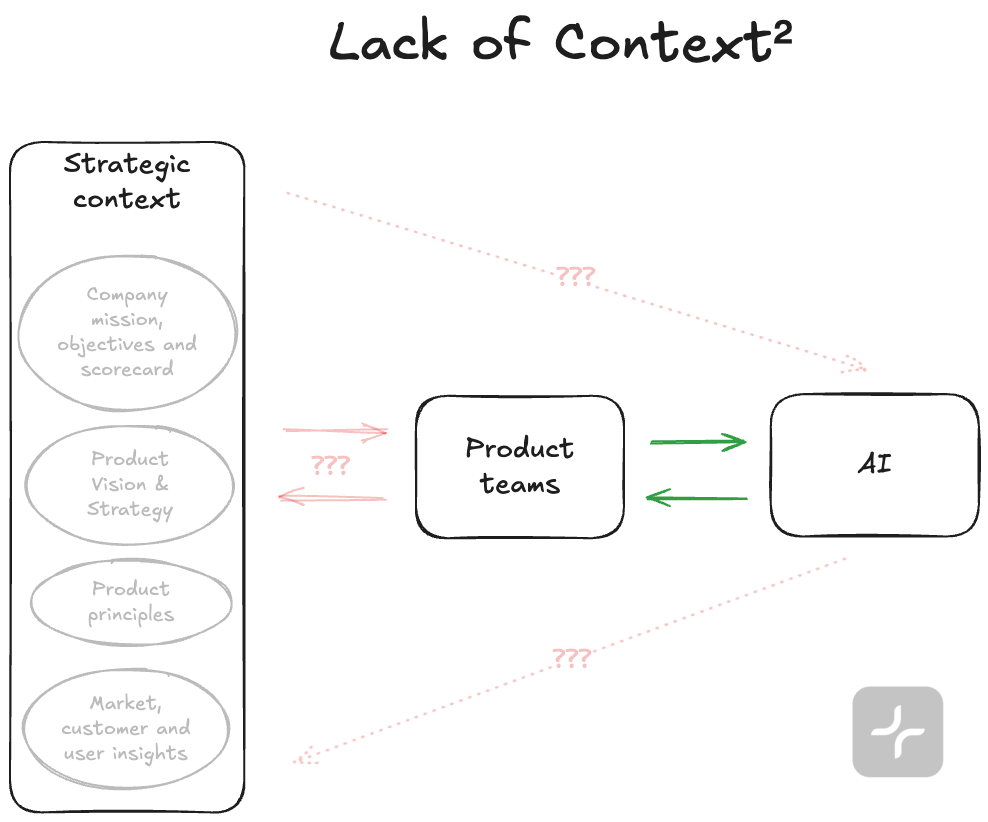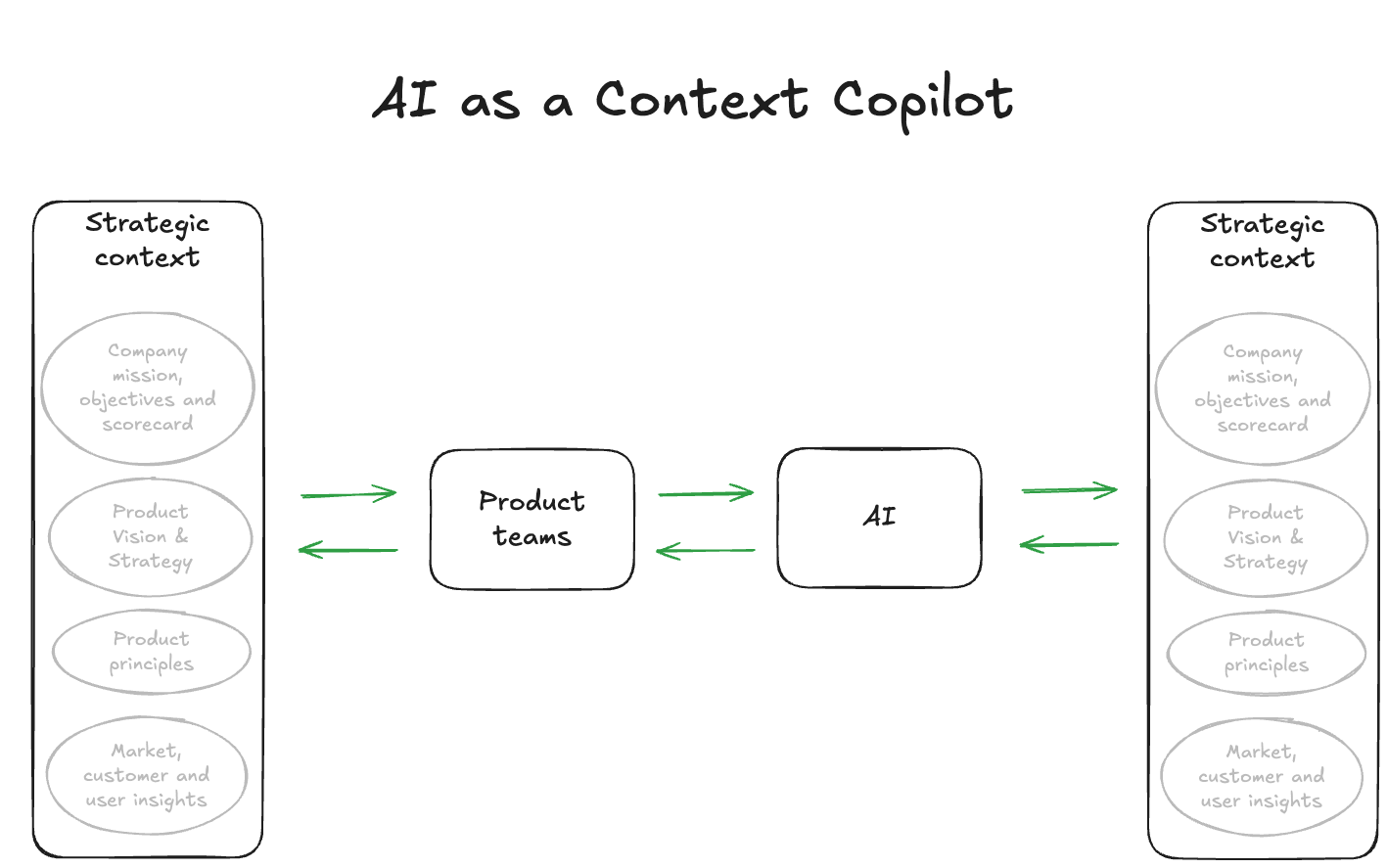Building great products requires product teams that can make good choices autonomously while staying aligned with what matters most for customers and the company.
One of the key levers that enables strong companies to do this is strategic context—the understanding that product teams need to make good decisions. It encompasses the company’s mission, scorecard and objectives, product vision, principles, and strategy.
Reference: Marty Cagan, “Coaching: Strategic Context”
Providing this context and evangelizing it have always been core responsibilities for product leaders. With the rise of AI, this responsibility is evolving.
Product teams are increasingly turning to AI tools for research, problem framing, ideation, solution design, and prioritization. The challenge is no longer just ensuring that team members have context—it’s also ensuring that the AI systems influencing their decisions do too.
This is why strategic context is more important than ever. When done right, AI can be transformative in helping companies develop better products. Done wrong, it creates real risks—pushing teams in multiple directions at once and creating speed without coherence.
This article explores both sides:
The risks of Lack of Context²—how misalignment compounds when teams and AI operate without solid strategic context
The opportunity to use AI as a Context Copilot—a force multiplier for alignment, autonomy, and clarity across your organization
The Challenge: What Lack of Context² Looks Like
Imagine a company with a dozen product teams. These teams lack a strong grasp of strategic context—and now each is using AI tools as sparring partners throughout the product development process.
Over time, teams increasingly rely on the answers these tools provide. They’re available 24/7, quick, and articulate. Getting insights from AI feels easier than digging into company documents or engaging in strategic discussions—especially if product leaders haven’t made that context easily accessible.
What might have once been a small knowledge gap—something a team could close with research or an internal chat—now grows into a larger problem. Teams move fast, trust the AI’s convincing answers, and start prototyping and shipping at lightning speed. They feel productive, using cutting-edge tools and generating more output than ever.
But without context, speed becomes drift
This is Lack of Context² in action: a team without context, guided by an AI without context. Misalignment squared.
The risk multiplies in larger organizations. Imagine 30+ teams, each using AI independently, all moving fast—but in different directions. Each team generates ideas, builds features, and ships at velocity, yet without a shared foundation.
The result?
A fragmented product. A diluted strategy. A collective loss of focus on solving the most meaningful customer problems.
The Opportunity: AI as a Context Copilot
Now flip the scenario.
Imagine an organization where teams deeply understand the mission, vision, strategy, principles, and objectives. They also use AI—but their AI systems are equipped with that same context.
The models are trained on strategy documents, product vision and principles, company OKRs, and the latest business and customer insights. When teams use these systems to explore new ideas, analyze problems, or evaluate trade-offs, the AI reinforces the company’s strategic intent—shedding light on the right direction and guiding teams toward aligned outcomes.
This is the essence of Context Engineering: intentionally designing systems and workflows so both humans and AI operate from the same strategic foundation
Done well, AI becomes a Context Copilot:
Proposing ideas that align with strategy and are grounded in insight
Flagging solutions that contradict principles or values
Helping evaluate ideas through the right business and customer lens
Stress-testing decisions against objectives
Instead of eroding strategy, AI reinforces it.
For leaders, this creates a scalable extension of their influence—a way to bring strategic context into the everyday work of every team. In this setup, AI drives alignment, safeguards focus, and strengthens the culture of empowered product teams.
The Benefits of Using AI to Amplify Strategic Context
This isn’t just about mitigating risk—it’s about unlocking enormous upside.
Leaders can use AI as an ally to scale context across large or fast-growing organizations, making strategic alignment part of how teams operate every day.
With the right setup, AI can:
Funnel attention toward what matters most, providing guardrails that keep teams focused on the right problems
Highlight misalignment by flagging when ideas or actions contradict principles or strategy
Illuminate better paths by reinforcing product values and strategic goals
Amplify consistency across teams, ensuring that decisions made in different rooms—or even countries—flow from the same foundation
Support autonomy by helping teams make sound decisions even when leaders aren’t in the room
AI becomes a multiplier for leadership impact. It allows context to scale beyond conversations or documents, actively shaping the decisions made by every team, every day.
Used well, it ensures that speed translates into progress—not chaos. Used poorly, it creates the very condition we want to avoid: Lack of Context².
Why Product Leaders Must Act Now
The responsibility of providing strategic context has doubled. Leaders now have two audiences for context:
The product teams
The AI systems influencing their thinking
If either lacks context, decisions drift. If both lack it, they drift faster—and the illusion of progress grows stronger.
With AI, companies can easily fall into a trap: “moving fast” by producing more output than ever while actually losing strategic coherence and focus. The result? A company that’s busy building but not truly progressing.
But when both teams and AI share the same context, human creativity and machine intelligence row in the same direction. The speed and insights of AI combine with human judgment and empathy, unlocking tremendous value
This is the next competitive advantage: companies that learn to use AI as a lever for context will move faster and smarter than those that don’t.
What Leaders Need to Do
It’s time for product leaders to ensure that strategic context is embedded not only in how teams operate but also in how they collaborate with AI.
Think of AI as part of your workforce and take deliberate steps to guide and govern it.
Here’s how to start:
Assess the AI tool ecosystem and define which tools to use and how to use them
Train teams to understand how to use AI effectively and safely—create room for experimentation and learning
Onboard AI tools with context so they can make relevant, high-quality suggestions
Design frameworks to keep context current as strategies and insights evolve
Integrate AI tools thoughtfully with existing systems and processes
Continuously evaluate how well AI tools reinforce, not distort, the strategic context
The Path Forward
These are exciting times. AI can enable product teams to do things once unimaginable—but only if used thoughtfully.
For product leaders, the mission is clear: use AI as a context amplifier, a force multiplier for alignment, and a strategic ally that helps teams build better products, faster, and with greater clarity than ever before.
In future posts, I’ll share practical tactics and frameworks for product leaders who want to apply these ideas inside their own organizations.



